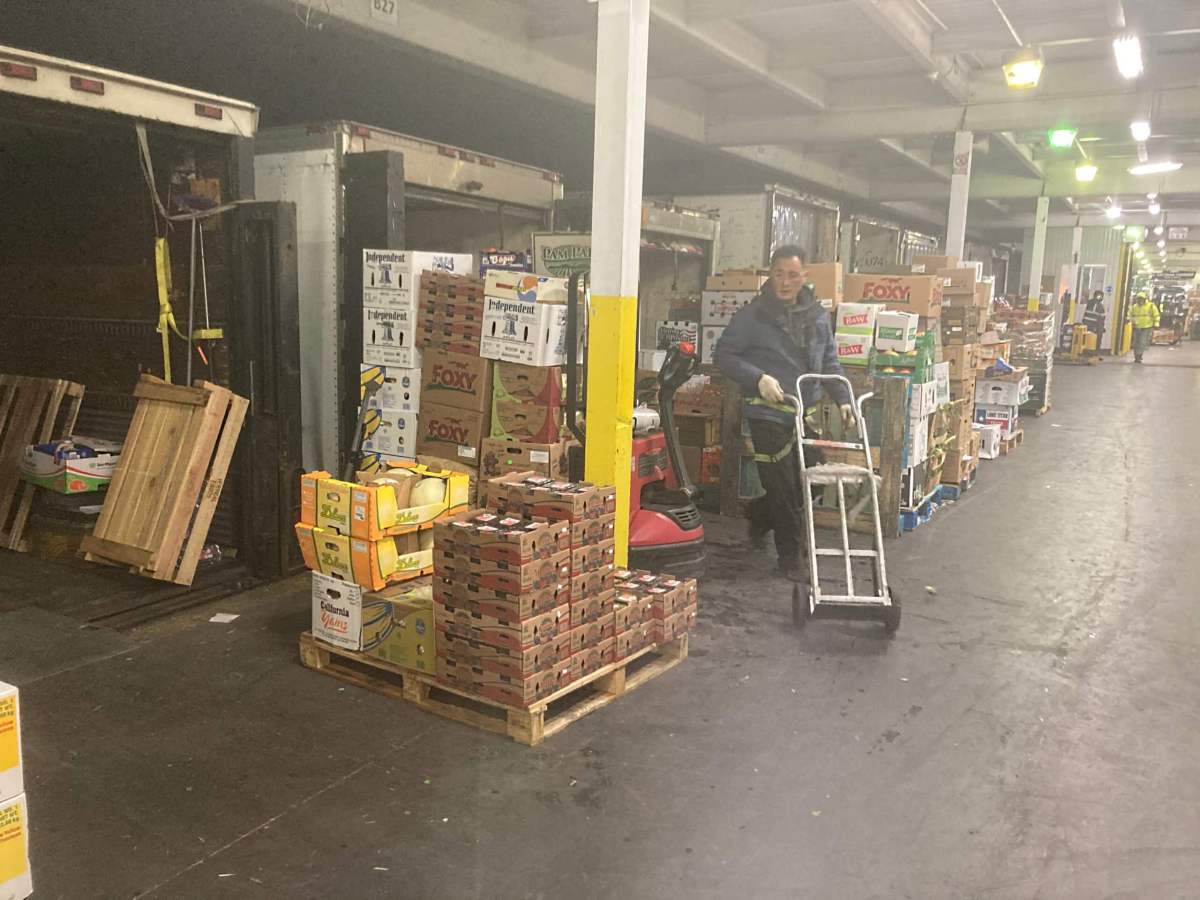Hours before the sun rose over a sleepy Bronx River on Tuesday, the inside of the Hunts Point Produce Market was filled with the whirring of machine lifts, casual condensation-filled conversations amongst employees heading into the tail-end of their late-night shifts, and an assembly line of retailers lining up to deliver 30 million pounds of produce and other Thanksgiving sides throughout the NYC metro region.
At around 4 a.m., a fleet of trucks representing some of the city and state’s best-known brand-name stores rolled past the market’s terminal entrance looking to equip and refill the shelves and pantries of their stores and restaurants before Thursday’s holiday.
Roughly 90% of the metro region’s Thanksgiving Day spread — sans turkey — will come from the refrigerated units of the Bronx’s Hunts Point Produce Market — the country’s biggest food distribution hub — which provides almost 5 billion pounds of food to city restaurants, supermarkets and bodegas, and an estimated 25% of the produce in the city.
Phillip Grant, chief executive of the Hunts Point Produce Market, told the Bronx Times that the market is also keeping produce prices low at a time when inflation and disruption in the supply chain add up to a Thanksgiving feast that is $10.74 or 20% higher than last year, according to Farm Bureau’s 37th annual survey.

The price of food in America rose more in the past 12 months than it has at any time since 1979 — a 13.1% increase over the past year — according to the U.S. Bureau of Labor’s Consumer Price Index. The price of eggs ballooned 38%, flour is up 22.7%, chicken 17.6%, milk 15.6%, ground beef 9.7% and bacon 9.2%. Fruits and vegetables saw a 9.3% increase as well.
For many of the market’s workers, including the security staff, handlers, packers and sellers, the busy pre-Thanksgiving distribution day is one in a year’s worth of busy days. The market sublets space to various private distributors and merchants, totaling four separate blocks of food suppliers from fruits to potatoes — a popular Thanksgiving production item — to onions and mushrooms.
Some experienced long-haul truckers like Daniel Esposito, who will be shipping goods to a Foodtown supermarket in Queens, has seen the market during leaner times in the ’80s and ’90s, stay open during the COVID-19 pandemic, and seen production and traffic outgrow and overwhelm the 55-year-old facility.
“You think how much (the market) produces, unless you do daily deliveries or come on a day like today, you rarely get the size and magnitude of what this market can do,” said Esposito. “It’s wild to see how much they can do and adapt when you think about how old this building is and how much of a nightmare it is to drive down here.”
On Tuesday, Esposito’s 53-foot-trailer, unfortunately, couldn’t clear the market’s terminal entrance, one of the disadvantages of the market’s outdated facility.
The produce market was built in 1962 on 40 acres, and has since grown to 113 acres with four warehouses. And thanks to $110 million in federal funds, the market is set to be redeveloped into a new 1 million-square-foot, state-of-the-art intermodal freight facility and a refrigerated warehouse space.
“What would surprise a lot of people is the hard work that our merchants do to actually keep the price of produce affordable in the city because we’re in the business of keeping New York fed and also in the business of providing affordable produce,” said Grant. “Our infrastructure is aging and we need to revitalize … and really build a sustainable market for the future that could last a few generations, and that’s what we’re really trying to bring here in the Hunts Point Market.”
One of the market’s 30 merchants, Katzman Produce, is 325 employees strong and has its own fleet of delivery trucks to get produce as far away as Massachusetts and Virginia.
The new facility will meet federal requirements from the U.S. Food and Drug Administration’s new Food Safety Modernization Act — eliminating 1,000 diesel-powered refrigerated trailer units currently idling onsite as additional storage and significantly reducing emissions in the surrounding community.
A lot of the merchants have put their own personal money into making this market ready for the 21st century,” said Stefanie Katzman, executive vice president of Katzman. “I know us personally here at Katzman, we’ve invested a lot in refrigerated paneling, new refrigeration units to really protect the culture chain and the produce. I’m very excited for the work that we’re doing to get a new market.”

As a Katzman salesman/buyer at the market, Anthony Andreani loves the front-facing role of his job — not only selling fresh produce, but also for being a main point of contact for market customers — which can be tough to tackle on busy holiday stretches like Thanksgiving.
“All of this, especially on our busiest days, comes down to teamwork and communication,” said Andreani. “Communicating with the customers to understand what their needs are. Us going back to our growers and our vendors, seeing what they have available and getting (product) on trucks.”
Reach Robbie Sequeira at rsequeira@schnepsmedia.com or (718) 260-4599. For more coverage, follow us on Twitter, Facebook and Instagram @bronxtim
























